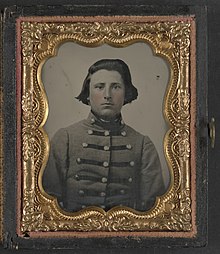This article includes a list of references, related reading, or external links, but its sources remain unclear because it lacks inline citations. (September 2014) |
The 5th Virginia Infantry Regiment was an infantry regiment raised in Virginia for service in the Confederate States Army during the American Civil War. It fought in the Stonewall Brigade, mostly with the Army of Northern Virginia. The regiment was known as the "Fighting Fifth".
| 5th Virginia Infantry Regiment | |
|---|---|
 Flag of Virginia, 1861 | |
| Active | May 1861 – Spring 1865 |
| Disbanded | 1865 |
| Country | |
| Allegiance | |
| Branch | |
| Type | Regiment |
| Role | Infantry |
| Engagements | American Civil War |
| Commanders | |
| Notable commanders | Col. William S. Baylor Col. Kenton Harper |


The 5th Virginia Infantry Regiment was organized in May, 1861, under Colonel Kenton Harper. Eight companies were from Augusta County and two from Frederick County. The unit became part of the Stonewall Brigade and served under Generals T.J. Jackson, Richard B. Garnett, Charles Sidney Winder, Elisha F. Paxton, James A. Walker and William Terry.
It saw action at First Manassas, First Kernstown, and in Jackson's Valley Campaign. Later the 5th participated in the campaigns of the Army of Northern Virginia from the Seven Days' Battles to Cold Harbor, then was active in Early's Shenandoah Valley operations and around Appomattox.
It reported 9 killed, 48 wounded, and 4 missing at First Kernstown, had 4 killed, 89 wounded, and 20 missing at Cross Keys and the Port Republic, and suffered 14 killed and 91 wounded at Second Manassas. The unit sustained 120 casualties at Chancellorsville and of the 345 engaged at Gettysburg, sixteen percent were disabled. It surrendered 8 officers and 248 men.
The field officers were Colonels William S.H. Baylor, John H.S. Funk, William H. Harman, and Kenton Harper; Lieutenant Colonel Hazael J. Williams; and Majors Absalom Koiner and James W. Newton.
See also
editReferences
edit- This article incorporates public domain material from Civil War Soldiers and Sailors System. National Park Service.